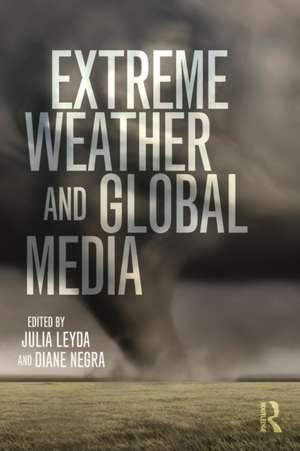Extreme Weather and Global Media
Editat de Julia Leyda, Diane Negraen Limba Engleză Paperback – 17 iun 2015
| Toate formatele și edițiile | Preț | Express |
|---|---|---|
| Paperback (1) | 355.20 lei 43-57 zile | |
| Taylor & Francis – 17 iun 2015 | 355.20 lei 43-57 zile | |
| Hardback (1) | 1109.18 lei 43-57 zile | |
| Taylor & Francis – 11 iun 2015 | 1109.18 lei 43-57 zile |
Preț: 355.20 lei
Nou
Puncte Express: 533
Preț estimativ în valută:
67.97€ • 71.15$ • 56.24£
67.97€ • 71.15$ • 56.24£
Carte tipărită la comandă
Livrare economică 07-21 aprilie
Preluare comenzi: 021 569.72.76
Specificații
ISBN-13: 9781138798793
ISBN-10: 1138798797
Pagini: 230
Ilustrații: 20 black & white halftones
Dimensiuni: 152 x 229 x 13 mm
Greutate: 0.43 kg
Ediția:1
Editura: Taylor & Francis
Colecția Routledge
Locul publicării:Oxford, United Kingdom
ISBN-10: 1138798797
Pagini: 230
Ilustrații: 20 black & white halftones
Dimensiuni: 152 x 229 x 13 mm
Greutate: 0.43 kg
Ediția:1
Editura: Taylor & Francis
Colecția Routledge
Locul publicării:Oxford, United Kingdom
Public țintă
Postgraduate and UndergraduateCuprins
Introduction: Extreme Weather and Global Media Julia Leyda and Diane Negra 1. Televising Superstorm Sandy: New Configurations of Poverty and Neoliberalism in Extreme Weather Coverage Jon Kraszewski 2. Eye of the Storm: CCTV, Surveillance and Media Representations of Extreme Weather Justin Carville 3. Picturing High Water: The 2013 Floods in Southeastern Germany and Colorado Susanne Leikam 4. "Blowtorch Britain:" Labor, Heat and Neo-Victorian Values in Contemporary UK Media Paula Gilligan 5. Post-Political Crisis Management: Representations of Extreme Weather in Swedish Media Annika Olsson 6. Disaster Data, Data Activism: Grassroots Responses to Representing Superstorm Sandy Max Liboiron 7. Mangoes and Monsoons: South Asian Media Coverage of Environmental Spectacles Sujata Moorti 8. Rain with a Chance of Radiation: Forecasting Local and Global Risk After Fukushima Laura Beltz Imaoka
Notă biografică
Julia Leyda is Associate Professor in the Department of English Literature at Sophia University in Tokyo. She has published articles in Jump Cut, Television and New Media, American Quarterly, and Cinema Journal. She is the editor of Todd Haynes: Interviews (University Press of Mississippi, 2014).
Diane Negra is Professor of Film Studies and Screen Culture and Head of Film Studies at University College Dublin. She is the author, editor or co-editor of eight books, the most recent of which is Gendering the Recession: Media and Culture in an Age of Austerity (Duke University Press, 2014). She is co-editor of Television and New Media.
Diane Negra is Professor of Film Studies and Screen Culture and Head of Film Studies at University College Dublin. She is the author, editor or co-editor of eight books, the most recent of which is Gendering the Recession: Media and Culture in an Age of Austerity (Duke University Press, 2014). She is co-editor of Television and New Media.
Recenzii
"Weather is all around us: proliferating in every medium; swirling through communities; becoming more volatile in the epoch of climate change. This astonishing, affecting volume exquisitely arrays the social and intermedial ecologies of everyday nature—and the extremities of contemporary existence." —Janet Walker, University of California Santa Barbara
"This is a highly original collection of essays, bringing the insights of a critical media studies to the environmental humanities in order to elaborate the complexities of the cultural politics implicated in the 'hypermediation' of extreme weather events." —Graeme Turner, University of Queensland
"This is a highly original collection of essays, bringing the insights of a critical media studies to the environmental humanities in order to elaborate the complexities of the cultural politics implicated in the 'hypermediation' of extreme weather events." —Graeme Turner, University of Queensland
Descriere
In the two decades bracketing the turn of the millennium, large-scale weather disasters have been inevitably constructed as media events. As such, they challenge the meaning of concepts such as identity and citizenship for both locally affected populations and widespread spectator communities. This timely collection pinpoints the features of an often overlooked yet rapidly expanding category of global media and analyzes both its forms and functions. Specifically, contributors argue that the intense promotion and consumption of 'extreme weather' events takes up the slack for the public conversations society is not having about the environment, and the feeling of powerlessness that accompanies the realization that anthropogenic climate change has now reached a point of no return. Incorporating a range of case studies of extreme weather mediation in India, the UK, Germany, Sweden, the US, and Japan, and exploring recent and ongoing disasters such as Superstorm Sandy, the Fukushima nuclear crisis, flooding in Germany, and heat waves in the UK, Extreme Weather and Global Media generates valuable inquiry into the representational and social characteristics of the new culture of extreme weather.












